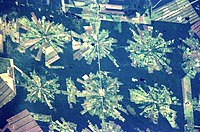
Climate and forest loss interactively restructure trait composition across a human‐modified landscape
Sign Up to like & getrecommendations! Published in 2022 at "Ecology and Evolution"
DOI: 10.1002/ece3.9361
Abstract: Abstract Traits determine species response to climate conditions and the match between phenotypes and climate mediates spatial variation in species composition. These trait–climate linkages can be disrupted in human‐modified landscapes. Human land use creates forest… read more here.
Keywords: trait covariance; climate; trait; seed ... See more keywords

Orangutan movement and population dynamics across human-modified landscapes: implications of policy and management
Sign Up to like & getrecommendations! Published in 2021 at "Landscape Ecology"
DOI: 10.1007/s10980-021-01286-8
Abstract: Agricultural expansion is a leading cause of deforestation and habitat fragmentation globally. Policies that support biodiversity and facilitate species movement across farmland are therefore central to sustainability efforts and wildlife conservation in these human-modified landscapes.… read more here.
Keywords: movement; modified landscapes; landscape; management ... See more keywords

Effects of native forest and human-modified land covers on the accumulation of toxic metals and metalloids in the tropical bee Tetragonisca angustula.
Sign Up to like & getrecommendations! Published in 2021 at "Ecotoxicology and environmental safety"
DOI: 10.1016/j.ecoenv.2021.112147
Abstract: The intensive shift on land cover by anthropogenic activities have led to changes in natural habitats and environmental contamination, which can ultimately impact and threat biodiversity and ecosystem services, such as pollination. The aim of… read more here.
Keywords: native forest; land; angustula; human modified ... See more keywords

The palm Syagrus coronata proliferates and structures vascular epiphyte assemblages in a human-modified landscape of the Caatinga dry forest
Sign Up to like & getrecommendations! Published in 2020 at "Journal of Tropical Ecology"
DOI: 10.1017/s0266467420000073
Abstract: Abstract The proliferation of disturbance-adapted species in human-modified landscapes may change the structure of plant communities, but the response of biodiversity to human disturbances remains poorly understood. We examine the proliferation of the palm, Syagrus… read more here.
Keywords: palm; syagrus; coronata; human modified ... See more keywords

The conservation value of human-modified landscapes for the world’s primates
Sign Up to like & getrecommendations! Published in 2019 at "Nature Communications"
DOI: 10.1038/s41467-018-08139-0
Abstract: Land-use change pushes biodiversity into human-modified landscapes, where native ecosystems are surrounded by anthropic land covers (ALCs). Yet, the ability of species to use these emerging covers remains poorly understood. We quantified the use of… read more here.
Keywords: use; conservation value; modified landscapes; conservation ... See more keywords

Tree growth and stem carbon accumulation in human-modified Amazonian forests following drought and fire
Sign Up to like & getrecommendations! Published in 2018 at "Philosophical Transactions of the Royal Society B: Biological Sciences"
DOI: 10.1098/rstb.2017.0308
Abstract: Human-modified forests are an ever-increasing feature across the Amazon Basin, but little is known about how stem growth is influenced by extreme climatic events and the resulting wildfires. Here we assess for the first time… read more here.
Keywords: carbon; stem carbon; human modified; carbon accumulation ... See more keywords

Seeing the woods through the saplings: Using wood density to assess the recovery of human‐modified Amazonian forests
Sign Up to like & getrecommendations! Published in 2018 at "Journal of Ecology"
DOI: 10.1111/1365-2745.12991
Abstract: Most of the world's remaining tropical forests have been affected by either selective logging, understorey fires, fragmentation or are regrowing in areas that were previously deforested. Despite the ubiquity of these human‐modified forests, we have… read more here.
Keywords: recovery; wood density; density; human modified ... See more keywords

Habitat selection in natural and human-modified landscapes by capybaras (Hydrochoerus hydrochaeris), an important host for Amblyomma sculptum ticks
Sign Up to like & getrecommendations! Published in 2020 at "PLoS ONE"
DOI: 10.1371/journal.pone.0229277
Abstract: Human activities are changing landscape structure and function globally, affecting wildlife space use, and ultimately increasing human-wildlife conflicts and zoonotic disease spread. Capybaras (Hydrochoerus hydrochaeris) are linked to conflicts in human-modified landscapes (e.g. crop damage,… read more here.
Keywords: landscapes capybaras; human modified; habitat selection; modified landscapes ... See more keywords

All forests are not equal: population demographics and denning behaviour of a recovering small carnivore in human modified landscapes
Sign Up to like & getrecommendations! Published in 2020 at "Wildlife Biology"
DOI: 10.2981/wlb.00760
Abstract: Landscapes occupied by recovering carnivore populations in Europe are highly modified by human activity. It is unclear how recovering predators will adapt and sustain populations in highly altered landscapes, with most existing research focused on… read more here.
Keywords: landscape; demographics denning; human modified; population demographics ... See more keywords

Neglected but Potent Dry Forest Players: Ecological Role and Ecosystem Service Provision of Biological Soil Crusts in the Human-Modified Caatinga
Sign Up to like & getrecommendations! Published in 2019 at "Frontiers in Ecology and Evolution"
DOI: 10.3389/fevo.2019.00482
Abstract: Biological soil crusts (biocrusts) have been recognized as key ecological players in arid and semiarid regions at both local and global scales. They are important biodiversity components, provide critical ecosystem services, and strongly influence soil-plant… read more here.
Keywords: human modified; ecosystem; biocrust cover; soil ... See more keywords